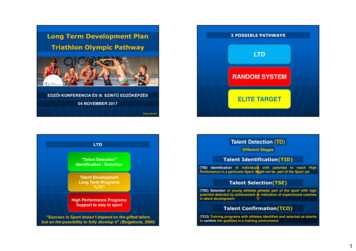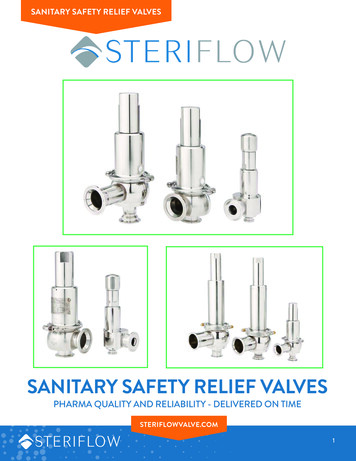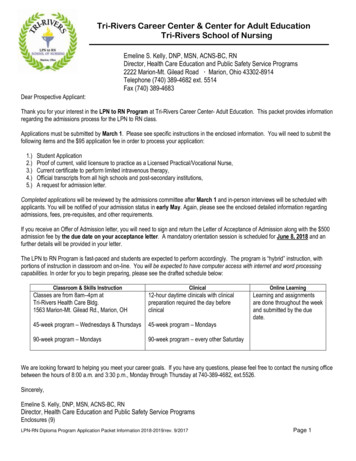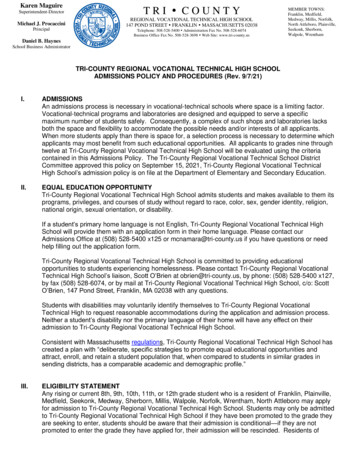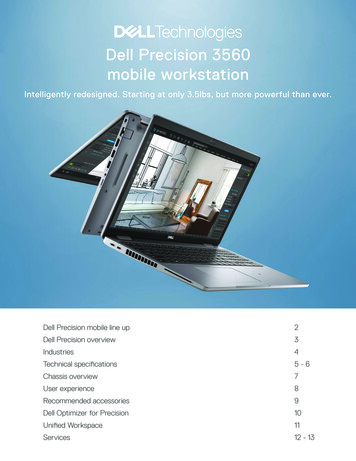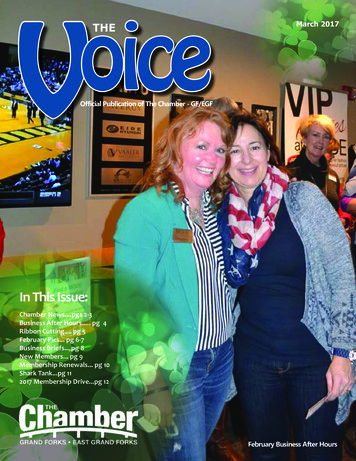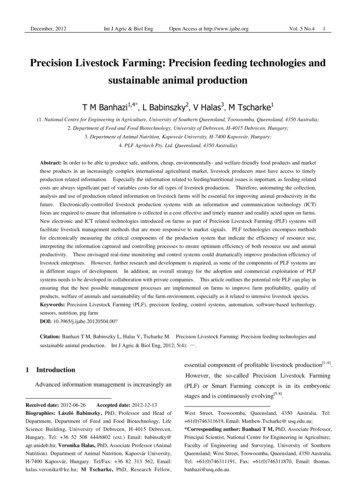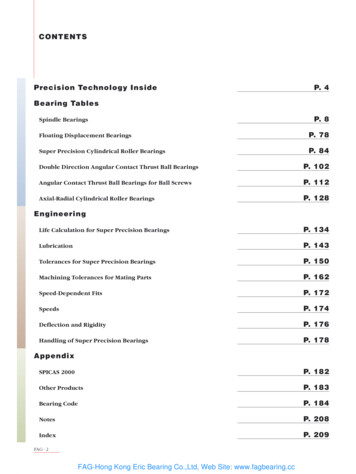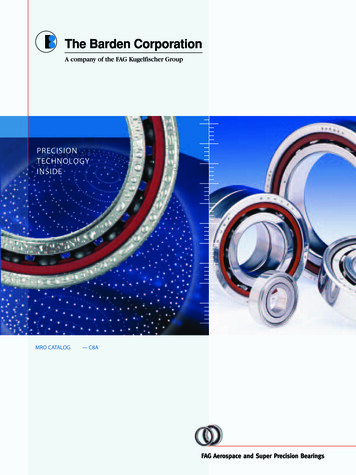
Transcription
PRECISIONTECHNOLOGYINSIDEMRO CATALOG— C8A
CONTENTSBearing Nomenclature, Key Terms.4–5Bearing Features — Types of Bearings, Bearing Closures . . . . . . . . . . . . . . . . . . . . . . . . . . . . . . . . . . . . . . . . . . 6 – 8Technical Information —Preloading, Radial Play, Limiting Speeds, Lubricants, Ceramic Hybrids . . . . . . . . . . . . . . . 9 – 13Ceramic Hybrids and X-Life Ultra Bearings. . . . . . . . . . . . . . . . . . . . . . . . . . . . . . . . . . . . . . . . . . . . . . . . . 14 – 15Deep GrooveRadial Ball Bearings —Open, Shielded and with Flexeals . . . . . . . . . . . . . . . . . . . . . . . . . . . . . . . . . . . . . . . . . . . . . . .Angular ContactBall Bearings —Non-Separable . . . . . . . . . . . . . . . . . . . . . . . . . . . . . . . . . . . . . . . . . . . . . . . . . . . . . . . . . . . . . . . . . . 18 – 211900HCZSB Series/Small Ball, High Speed100HC200HC300H.Ball Screw Support Bearings—Series L and BSB Series . . . . . . . . . . . . . . . . . . . . . . . . . . . . . . . . . . . . . . . . . . . . . . . . . . . .Ex-Cell-OReplacement Bearings. 22 – 23. . . . . . . . . . . . . 24 – 25.Angular ContactBall Bearings — Separable . . . . . . . . . . . . . . . . . . . . . . . . . . . . . . . . . . . . . . . . . . . . . . . . . . . . . . . . . .Deep Groove RadialInstrument Ball Bearings —Open, Shielded, Flangedand with Flexeals . . . . . . . . . . . . . . . . . . . . . . . . . . . . . . . . . . . . . . . . . . . . . . . . . . . . . . .Cylindrical Roller Bearings. . . . 26. . . . . . . . .26. . . . . . . . . . . . . . . . . . .27. . . . . . . . . . . . . . . . . . . . . . . . . . . . . . . . . . . . . . . . . . . . . . . . . . . . . . . . . . . . . 28 –Double Direction Angular Contact Thrust Ball BearingsBearing Mounting and FittingReplacement Interchange TablesBarden · 216 – 1729. . . . . . . . . . . . . . . . . . . . . . . . . . . . . . . . . . . . . . . 30 – 31. . . . . . . . . . . . . . . . . . . . . . . . . . . . . . . . . . . . . . . . . . . . . . . . . . . . . . . . . . . 32 – 35. . . . . . . . . . . . . . . . . . . . . . . . . . . . . . . . . . . . . . . . . . . . . . . . . . . . . . Back Cover
THE FINEST BEARINGS THAT CAN BE MADEBarden’s focus on superprecision bearing technology haslong been driven by the needs of ourcustomers for greater accuracy, higher running speeds,longer life and a sensitivity to cost.As a result, our entire R&D, design and manufacturing philosophy revolves around delivering innovativebearing solutions, better product reliability and lowersystem costs.Meeting these stringent demands requires constantinteraction with custom ers to learn more abouttheir specific application r equirements. Our own R&Defforts — along with our support of leading universitymechanical engineering and metallurgical researchprojects — have laid the foundation for the developmentof new, ever mor e reliable precision bearing products.While bearing tolerances are well-defined byDIN/ISO or ABEC standards, Barden super precisionbearings routinely exceed even these stringentguidelines, r esulting in the production of the finestbearings that can be made.In addition to meeting — or exceeding — thedemanding tolerance requir ements of P4/ABEC 7specifications, there are other Barden-imposedperformance features not covered by these standards.As a result, Barden super precision bearingsset standards unchallenged by any other bearingmanufacturer in the world today when it comes toperformance reliability, gr eater accuracy, higherrunning speeds and longer life.Barden’s extensive pr oduct line means thatwhatever your application — from milling machinesto textile winders to wood working machines —there’s a precision bearing solution that’s right for you.Barden · 3
NOMENCLATUREBearing numbers used in the pr oduct tables are basicnumbers, composed of up to six segments (see below)of letter or numeral symbols identifying the principalcharacteristics of the bearing. Complete identification ofeach bearing r equires additional segments (oppositepage), added to the basic bearing number.SERIES1900100200300ZSBRBSBUltra LightExtra LightLightMediumSmall Ball DesignInstrument BearingsMetric Ball ScrewSupport BearingsL — Inch Ball ScrewSupport BearingsRR – Double Seal,AngularContactonly.E 25 V – Single Viton.VV– Double Viton.201EXAMPLE:SR4S – AISI 440C stainless steel.M – AISI M50 tool steel.C – Ceramic balls, SAE 52100bearing steel rings.CS – Ceramic balls, AISI 440C stainlesssteel rings.CM– Ceramic balls, AISI M-50 toolsteel rings.XC – X-Life Ultra, Cronidur 30 Rings,ceramic balls.Sealed Bearings:F – Single Flexeal. FF – Double Flexeal.C 15 CAbsence of a symbol indicates SAE 52100(chrome) bearing steel.Shielded Bearings:S – Single Shield.SS – Double Shield.HCLetter “X” followed by number(s)indicates special features. Becauseof frequent usage, certain featureshave permanently assignedX numbers.They include:X200 – Oil-tight seal between outerring recess and shield.Y – Single Barseal. YY– Double Barseal.EXAMPLE:MATERIALSPECIAL FEATURES*Absence of a symbol indicates open bearing.CONTACT ANGLE———————(BALLS & RINGS)CLOSURE*X204– Customer part numbermarked on bearing O.D.X205– Full ball complement(angular contact H-typeonly).Consult Barden for information onspecial features for specific series.RRWSSBEARING TYPENo symbol is used to denotedeep groove bearings.B – Angular ContactBearing with separablerelieved inner ring.H – Angular Contact Bearingwith non-separable relievedouter ring.J – Angular Contact Bearingwith non-separable relievedinner ring.CAGENo symbol is used to indicate the standardcage for the specific bearing size as illustratedin column headings in the dimensional tables.Cage types other than standard will be includedin the part number in this position. Examplesof frequently used non-standard cages are:W – Two-piece, loosely clinched,pressed metal.TA – One-piece side assembled, phenolic.T– Two-piece riveted, aluminum-cladphenolic.TMT– One-piece side assembled, nylon 66.Descriptive data on all cages is listed on p. 8.ABMA STANDARDSGrades of precision have been set by the Annular Bearing Engineers Committee of the ABMA. Conventional ball bearings are manufagrades ABEC 1, ABEC 3, ABEC 5, ABEC 7 and ABEC 9 (highest). All Barden bearings in this catalog are produced to class ABEC 7 orBarden · 4ctured to precisionABEC 9.
DUPLEXINGRADIAL RUNOUTU – Single universal bearing. Any arrangement.DU– Set of two universal bearings.DB– Set of two bearings. Back-to-backarrangement.Only special radial runouts are shown inM & I bearing numbers and are identifiedby letter “E”.E – Radial runout less than standardtolerances. Consult Barden for details.When “E” is followed by letter “R”,high point of eccentricity is marked onbearing according to the following code:DF – Set of two bearings. Face-to-facearrangement.R – Inner ring marked for high point ofeccentricity.DT – Set of two bearings. Tandem arrangement.R1 – Outer ring marked for high point ofeccentricity.R2– Both inner and outer rings marked forhigh points of eccentricity.PRELOADL Light M Medium H HeavyLUBRICATIONType of lubricant used is always indicatedin bearing number on packaging. Letter “O”denotes oil, letter “G” denotes grease. Numbercodes following letters indicate type of lubricant.Lubricants frequently used are:OilsO-9 –O-11 –O-14 –O-40 –GreasesG-2 –G-18 –G-33 –G-42 –G-46 –G-73 –G-74 –G-75 –K3VRADIAL PLAYExxon Beacon 325Nye Rheotemp 500Mobil Grease #28Nye Rheolube 350-SBG-2Kluber ISOFLEX NBU-15Arcanol L-55Exxon Unirex N3Arcanol L-75O-11DULX3Exxon Aviation Instrument OilWinsorlube L-245XExxon 2389 Turbo OilExxon Coray 100ECG-2FUNCTIONAL TESTCALIBRATIONNumeral indicates range of radial play fordeep groove bearings.For angular contactbearings, no code is shown for standardcontact angles.Most miniature and instrument bearings areavailable with low torque characteristics.Variations in torque levels are designated bythe following symbols:Bearing with calibrated bore or O.D. is denotedby letter “C”. Coding used is as follows:Note: Radial play code number is precededby letter “K” when previous section of bearingnumber ends in a number. Letter “K” functionsonly as a separating symbol to avoid confusion.VK – Very low starting torque.CXO– Calibration of bore only.VM – Very low running torque.COX– Calibration of O.D. only.VT – Actual torque trace furnished with eachVM level bearing.C44 – Grouping of .00005", bore and O.D.V – Guaranteed low maximum torque level.Consult Barden for specific torque levels.(Note: Prior designation for guaranteed verylow maximum torque levels wasVL.)C– Bore and O.D. tolerance rangeseparated into increments of .0001"and group indicated on packaging.C40 – Bore only calibrated in groups of.000050".C04 – O.D. only calibrated in groups of.000050".Barden · 5
BEARING FEATURESTypes of BearingsThe three basic types of ball bearings offered in this catalogare Deep Gr oove, Angular Contact with Separable InnerRing (B T ypes), and Angular Contact with Non-SeparableInner or Outer Rings (H and J T ypes).Deep Groove BearingsDeep groove bearings have full shoulders on both sidesof the raceways of both inner and outer rings, with cagesto separate the balls. The deep groove design per mitsthe support of either radial or thrust loads. Because ofthis versatility they are pr eferred for many applications.Offered in many sizes, with a variety of cage types andin open, shielded, and sealed styles, they are the logicalchoice for first consideration.Typical deep groove bearings, open and shielded.Barden · 6Angular contact bearings. Non-separable type H on left; separable type Bon right. Shown with standard phenolic cages.Angular Contact BearingsAngular contact bearings are ideally suited for high speedapplications where both axial and radial loads are to besupported, and where system rigid ity requires preloading.The design inherently limits thrust loads to one dir ection,and are generally used in pairs or sets. Radial load supportis limited and occurs only when thrust loads are pr esentor preload is used.The non-separable (H type) angular contact designpermits using a larger complement of balls than is possiblein the same size deep groove bearing. For this reason ithas greater capacity. It also has higher speeds because ofthe phenolic one-piece cage.The separable (B type) angular contact bearing utilizescages designed to retain the balls when the outer ringassembly (including cage and balls) is separated from theinner ring. This type of bearing has the same high speedcapability as the H type non-separable angular contactbearing. The separable design has advantages for certainapplications.Separable bearings simplify assembly of units wherebearings are located in blind holes. The separable featurealso permits dynamic balancing of a rotating componentwith inner rings mounted in place, apart from the outerring and housing.Both separable and non-separable angular contactbearings utilize machined phenolic cages.
Ball Bearing ClosuresClosures (shields and seals) serve essentially the samepurpose but to varying degrees. Each type of closure: Excludes contamination. Helps r etain lubricants. P rotects the internal assembly of the bearing from damageduring handling or assembly.The availability of shields and seals is shown in the tablesthat follow.All types of closures are assembled in the outer ringin a manner as to provide controlled radial positioningwith minimum distortion of the ring.Stainless Steel ShieldsShields are precision stamped of stainless steel to acontoured configuration to providestrength and rigidity, resistanceto vibration, and positive radialand axial positioning against theshield shoulder in the outer ring.The shield does not contact theinner ring and thus does not affect bearing perfor mance.FlexealsThe Flexeal is a Barden-developed seal with superiorhigh speed characteristics. A thin layer of inert fibrousmaterial is permanently bonded to an aluminum washer,properly shaped by stamping, and positioned in the outerring just as a shield. The fiber absorbs a proper amountof lubricant which is continuouslyfed to the ground seal wiping faceon the inner ring notch. PositiveFlexeal positioning provides aclose control of seal wipingaction, resulting in higher speedcapability (compared with ot her seal designs) after run-in.Flexeals are recommended in applications where contamination is generated around the bearing or in equipmentwhich must operate in a contaminated environment.Bearings with Flexeals are generally used at speedswhere the dominant factors in torque are seal friction pluslubricant drag, which vary with type of lubricant, speed,and operating temperature. Flexeals may be used attemperatures up to 300 F. A maximum temperature of350 F is acceptable for short periods. Total torque or powerrequirements are best determined by test in the application.BarsealsThe barseal is a molded rubberseal which incorporates a metalstiffening insert. This designprovides maximum volume withinthe bearing for lubrication. Speedconsiderations limit their use togrease-lubricated bearings with P or TMT cages. Ef fectiveouter ring sealing makes these seal s preferred with outerring rotation. Maximum operating temperature is 225 F.Sealed Angular Contact Spindle BearingsSealed spindle bearings allow the use of a moreeconomical grease lubrication system. These bearingsare factory-filled with Barden’s high- performance G-75grease, then fitted with “non-contact” seals on both sides.The advantages of Barden’ssealed spindle bearings include: A non-contacting seal design. Gr eased for life lubrication. Box-to-spindle (r eady forassembly). Interchangeable with standard spindle bearings. Proper grease quantity. Controlled gr easing process. Elimination of contamination during handling. Enhanced perfor mance due to added sealing andgrease near contact zone especially in verticalapplications.Barden · 7
BEARING FEATURESCagesBarden deep groove and angular contact bearings areavailable with different types of cages offering a choiceof performance characteristics for a range of applications.Deep GroovePrincipal cage designs for deep groove bearings are thepressed stainless steel, one-piece snap type (Q), usedin smaller sizes, and the two-piece ribbon style (P), usedin larger sizes. The anti-windup cage (W), a Bardendevelopment, is available in many miniature and instrumentsizes. It is a two-piece light-weight ribbon style designed toprevent cage windup in sensitive low torque applications.Phenolic high speed cages are one-piece snap style (TA)in smaller sizes, and tw o-piece riveted phenolic, reinforcedwith aluminum (T) in larger sizes.Angular ContactOuter ring land-guided phenolic cages, designed forendurance at high speeds, are used in both separableand non-separable angular contact bearings.CAGES FOR DEEP GROOVE BEARINGSTypeCrossSectionQ–Crown type,snap cageIllustrationUseGeneral purposeStainlesssteelAISI 410General purposeStainlesssteelAISI 430AISI 305General purpose,low torqueinstrumentsStainlesssteelAISI 430AISI 305High speed,general purposePhenolicP–2-pieceribbon cage,full clinchW–2-piece ribboncage, looselyclinchedTA –Crown type,snap cageT–High speed,generalpurpose2-piecerivetedTMT –General purposeCrown type,snap cageMaterialPhenolicAluminumCladFillednylon66Light load, no lubrication, in stainlesssteel bearing only,BarTemphigh and low temp.,moderate speedTB –Crown type,snap cageTQ –High speed,quiet operationCrown type,snap cageDelrin*CAGES FOR ANGULAR CONTACT BEARINGSSeparable Type B:Outer ring has fullshoulders, inner ringhas one shoulder cutaway. Inner ring isremovable for mountingon the shaft separatelyfrom the outer ringassembly.Non-separable Type H:Inner ring has fullshoulders, outer has oneshoulder cut away witha small retaining lip atthe edge of raceway.Non-separable Type J:Outer ring has fullshoulders, inner ringhas one shoulder cutaway with a smallretaining lip at theedge of raceway.Other cages are available, but should not be specifiedwithout consultation with Barden Product lB† – 1-piece,for bearingswith separableinner ringsHigh speed,general purposePhenolicH† – 1-piece,for bearingswith nonseparableouter ringsHigh speed,general purposePhenolicHigh speed,general purposePhenolicJ † – 1-piece,for bearingswith nonseparableinner ringsBarden · 8* Reg. DuPont Trademark.† Symbol for bearing type. No symbol is used in nomenclature for standard cage.
TECHNICAL INFORMATIONPreloadingPreloading is the removal of internalclearance by placing a permanentthrust load on the bearings. Preloadingis used to satisfy one or more of thefollowing r equirements:1. Elimination of all radial andend play.2. Incr eased rigidity of a system.3. Reduction of non-repetitive runout.4. Limitation of change in contactangle between inner and outerring at very high speed.5. Prevention of ball skidding undervery high acceleration.Bearings shoul d not be preloadedmore than is necessary to obtain thedesired rigidity. E xcessive pr eloadsgenerate heat which reduces speedcapability and bearing life. Two basicmethods of achieving preload are:1. Use of universal duplexedbearings (DU).2. Spring preloading.Different types of spring preloading.Spring PreloadingThis is the simplest way to preload bearings. It shouldbe considered first, and used if all application r equirementscan be met. Most assemblies which do not require specificyield characteristics can be successfully spring preloaded.Spring preloading offers several advantages. Withproperly selected springs, it can be more constant thanother systems. It is generally less sensitive to dif ferentialexpansion, and offers more accommodation to minormisalignment. It also allows greater speeds than in rigidlypreloaded systems.Springs may be of many types — wavy washers,belleville washers, coil springs, spring block, etc.Rigid PreloadingTo achieve, solid preload must be carried out with greatcare using highly accurate parts for the adjustment. Threadedmembers with spacers and precision shims are typical meansof providing axial adjustment for preload. Lapped shimsmade to fine gradations of thickness are usually pr eferredsince screw threads can produce misalignment effects.Care must be taken in the mounting, design andinstallation procedures to avoid excessive preload dueto thermal changes that can develop between assemblyat room temperature and operating temperature.The speed reduction factors shown on page 12 mustbe used with a rigidly pr eloaded system.Barden · 9
TECHNICAL INFORMATIONDuplexed BearingsAngular ContactDuplexed bearings are made by r elieving selected facesof inner and outer rings by an amount called the preloadoffset. When the bearings are clamped into position, theoffset faces are br ought together, introducing a preloadinto the bearingsystem. Control of thepreload is achievedby controlling theamount of preloadoffset. All Bardenangular contactduplexed bearingsare universally ground(DU), thus enablingFig. 1: DB mounting before clamping.them to be mountedin any of the threebasic duplexingconfigurations.High points ofeccentricity are marked(asterisks) on innerrings of duplexed angular contact bearings toreduce assembly errors.Fig. 2: DB mounting after clamping.DB (back to back)Preload offsets of abutting faces of inner rings causingcontact angle lines of a pair of bearings to converge towardthe outside diameter of the bearings. Bearings are mountedwith marked faces or full shoulder side of outer ringstogether. Marked faces of outer rings and narrow facesof inner rings are mounted on separable (B) type bearings.This mounting method is preferred for applications wherehigh moment rigidity is r equired. DB mounting is alsopreferred where the shaft runs warmer than the housing,a common operating condition. Consequently, higheroperating speeds are possible.A Duplex DB pair before preloading (Fig. 1) has innerrings with a controlled preload offset. When inner ringsare clamped together on the shaft (Fig. 2) the specifiedpreload is established within the pair.DF (face to face)Preload offsets of abutting faces of the outer rings causinglines of contact of a pair of bearings to converge towardthe bearing bores. Mounted with unmarked or r elievedfaces of outer ringstogether. Unmarked facesof outer rings and widefaces of inner rings aremounted together on separable (B) type bearings.The DF mounting ispreferred in slow speedapplications where shaftbinding due to misalignment will be encountered.The DF pair beforepreloading (Fig. 3)Fig. 3: DF mounting before clamping.has outer rings withcontrolled preload offset.When outer rings areclamped together in housing (Fig. 4) the specifiedpreload is establishedwithin the pair of bearings.Fig. 4: DF mounting after clamping.Barden · 10
DT (tandem)Preload offsets of abutting faces of both inner and outer ringscreate parallel lines of contact. Mounted with marked or fullshoulder side of outerring of one bearingagainst unmarked orrelieved face of outerring of other bearing.DT pairs offergreater capacity withoutincreasing bearing size,through load sharing.Additionally, they canbe used to achieve aFig. 5: DT mounting before preloading.significant incr ease inaxial and radial rigidity.Duplex DT tandempair before preloading(Fig. 5) has innerand outer rings withequalized offsets. Whenmounted and thrustloaded (Fig. 6), loadsare shared equally byboth bearings.Deep GrooveDeep groove bearings may also be duplexed and must beordered as such. The mounting arrangements differ fromangular contact bearings in that marked faces are outboard forDB mounting and inboard for DF mounting. Shields and sealsare always installed on only the outboard sides of both rings.SpacersAll duplexed bearings can be separated by equal widthspacers (Fig. 7) to increase moment rigidity. Inner andouter ring spacer widths (axial length) must be matchedto within 0. 001mm, and faces must be square, flat andparallel within 0.001mm to preserve preload and alignment.Fig. 6: DT mounting after preloading.Fig. 7: Duplex bearing pairs with equal width spacers.Barden · 11
TECHNICAL INFORMATIONRadial PlayDeep Groove BearingsRadial play is the measured clearance in the radial dir ectionof an assembled bearing. Its magnitude is an importantfactor in bearing performance. Without radial play, interference fits and normal expansion of components cannotbe accommodated, causing binding and early failure. Highspeeds create heat through friction and r equire greaterthan normal radial play. If thrust loads predominate, higherradial play will tend to increase load capacity, life, andaxial rigidity. Low radial play codes are better suited forslow speed radially supported applications.Radial play is a measureof internal clearance andis influenced by measuringload and installationpractices. A high radial playvalue is not an indicationof lower quality or lessprecision.Deep groove bearings are available in a range ofradial play groups. Each radial play code, representslimits to the range of internal clearance. Code 3 andCode 5 bearings are more readily available than thosewith other radial play codes.Angular Contact BearingsRadial play, when combined with thrust loading, createsa line of contact between the ball and both races. The anglemade by this line and a plane through the ball centersis called the contact angle. Standard spindle size angularcontact bearings are assembled wi th a radial play thatprovides either a nominal 15 (C) or 25 (E) contact angle.The 15 contact angle bearing is standard for the 100H, 200H,and 300H series and pr ovides the optimum combination ofboth axial and radial capacity and rigidity. Wher e greateraxial rigidity is required, the 25 contact angle (100HE and200HE series) is pr eferred. Where extreme axial rigidity isnecessary, a 60 contact angle series is also available. Referto the section on ball screw support bearings, page 24.Limiting SpeedsSpindle BearingsLimiting speeds given in the product tables representmaximum values under ideal conditions, namely lightspring loads, adequate lubrication, and proper installationand alignment. When less than ideal conditions exist,speeds should be limited to lower values. Factors forcalculating the speed limits of rigidly preloaded bearingsystems are given below.SPEED REDUCTION (n* fr) FOR SPINDLE BEARING SETSBearing 0.750.600.350.650.500.30Large bearing distanceRADIAL PLAY — DEEP GROOVE BEARINGSBearing SizesFactor rf Bearing PreloadCode 3Code 5Code 634 – 39, 100 – 103.0002" to .0004".0005" to .0008".0008" to .0011"R0 – 10, R133 – R1810.0002" to .0004".0005" to .0008".0008" to .0011"104 – 107, 200 – 205.0002" to .0005".0005" to .0009".0009" to .0014"108, 206 – 209.0002" to .0005".0007" to .0012".0012" to .0017"109 – 110, 210.0004" to .0008".0008" to .0013".0013" to .0019"0.650.500.30111.0005" to .0010".0010" to .0016".0016" to .0023"0.720.570.37034(ABMA Designation)Barden · 12Locating bearingFloating bearing
LubricantsLubricants for typical applications are listed below.BardenCode*DesignationTemperatureLi mi ti ngdN Value†OILS0-9Exxon Avia. Instrument Oil– 65 F to 150 F1.5 10 60-11Winsorlube L-245X– 67 F to 175 F1.5 10 60-14Exxon 2389 Turbo Oil– 65 F to 350 F1.5 10 6GREASESG-2Exxon Beacon 325– 65 F to 250 F.40 10 6G-4Nye Rheolube 757 SSG– 40 F to 200 F.65 10 6G-12Chevron SRI-2– 20 F to 300 F0.4 10 6G-18Nye Rheotemp 500– 50 F to 350 F0.5 10 6G-33Mobil #28– 80 F to 350 F0.4 10 6G-42Nye Rheolube 350-SBG-2– 30 F to 250 F.65 10 6G-46Kluber Isoflex NBU-15– 40 F to 250 F.75 10 6G-74Exxon Unirex N3– 40 F to 300 F.65 10 6G-75Arcanol L-75– 60 F to 250 F1.2 10 6* See Bearing Numbering System pages 4 – 5.† dN bearing bore in mm (or inches 25.4) speed in RPM.Although greases will operate at maximum temperatureand speeds indicated, grease life will be limited. Significantlygreater grease life will be obtained at lower speeds andlower temperatures.Bearings are furnished with the following standardlubricants:Bearing TypesLubricant CodesAll deep groove, open bearings — instrument0-11All deep groove, open bearings — spindle0-9All shielded or sealed bearings — instrumentG-2All shielded or sealed bearings — spindleG-74All angular contact bearings — instrument0-11All angular contact bearings — spindle0-11All sealed angular contact bearings — spindleG-75All ball s crew s upport bearingsG-73TolerancesBarden precision ball bearings are manufactured to standardgrades of precision which establish tolerances for size andgeometric accuracy. These standards ar e set by the AnnularBearing Engineers Committee (ABEC) of the Anti-FrictionBearing Manufacturers Association, Inc. (ABMA). These samestandards have been accepted by the American NationalStandards Institute, Inc. (ANSI) and, through internationalagreements, conform essentially with standards for precisionball bearings developed by the International Organizationfor Standardization (ISO).Barden manufactures spindle and turbine bearings toclass ABEC 9 and instrument bearings to class ABEC 7P.Handling BearingsAll Barden bearings are manufactured, assembled, inspectedand packaged in a strictly contr olled environment.If the quality and high performance potential builtinto precision bearings is to be realized by the bearinguser, the same degree of car e and cleanliness should beused in handling and installing the bearings.Achievement of the r equired degree of cleanlinessrequires that all work spaces, tools, transport equipment,fixtures and the pa rts mated to the bearings be clean.Anyone handling bearings should recognize the need forcareful handling and cleanliness.Guidelines for Handling Bearings Keep bearings in their original packaging until installation. Barden bearings are demagnetized prior to shipment. Ifthere is any indication that bearings have become magnetized, which would attract contaminants, the wrappedbearings should be passed through a demagnetizer. Do not wash new bearings. Open bearings ar e lubricatedwith a petroleum-base oil which is compatible with oilmist lubricating systems and most spindle bearing greases.Sealed and shielded bearings ar e grease lubricated. W ear non-shedding, clean finger coverings, like plasticgloves or use tweezers when handling bearings. Use clean, burr-free tools, not painted or chrome-p lated. T ransmittal of forces th rough the bearing must beprevented to avoid brinelling which can damagebearings. Apply force only to the ring being fitted. Do not hammer. Use an arbor press or induction heater. Make sure outer rings are free to float for shaft expansion(if design r equires a floating bearing arrangement). If it is ever necessary to open the packaged bearingexcept for installation, it should be stored in a clean,covered container with proper identification prior toinstallation. The full nomenclature w ill appear only onthe original package.Barden · 13
CERAMIC HYBRIDS AND X-LIFE ULTRA BEARINGSCeramic HybridsUse of ceramic (silicon nitride) balls in place of steelballs can radically improve bearing performance severalways. Because ceramic balls are 50% lighter than steelballs, and because their surf ace finish is almost perfectlysmooth, they exhibit vibration levels two to seven timeslower than conventional steel ball bearings.Ceramic hybrid bearings also run at significantlylower operating temperatures, and can allow runningspeeds to increase by asCeramicmuch as 40% to 50%.Ball Bearing FeaturesBearings with ceramic60% lighter than steel ballsballs have been proven Centrifugal forces reducedto last up to five times Lower vibration levelslonger than conventional Less heat build upsteel ball bearings. Lower Reduced ball skiddingoperating temperatures Fatigue life increase
economical grease lubrication system. These bearings are factory- lled with Barden's high- performance G-75 grease, then tted with "non-contact"seals on both sides. The advantages of Barden's sealed spindle bearings include: A non-contacting seal design. Greased for life lubrication. Box-to-spindle (r eady for assembly).
